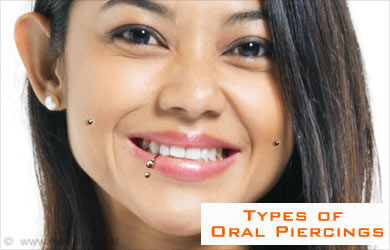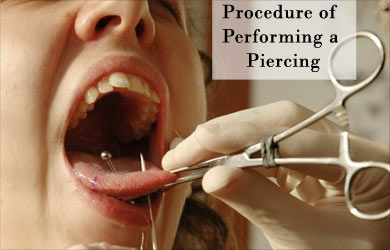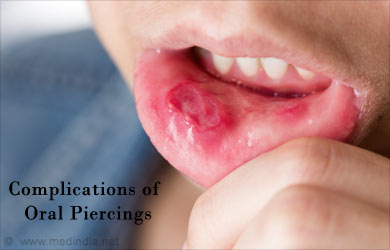- Oral Piercing: An Overview - (http://ijahsp.nova.edu/articles/vol6num3/pdf/cooper.pdf)
- Ioannis Plastargias, and Dimitra Sakellari; The Consequences of Tongue Piercing on Oral and Periodontal Tissues; ISRN Dentistry Volume 2014 (2014), Article ID 876510.
- RC Pramod, KV Suresh, Vidya Kadashetti, KM Shivakumar, Pramod S Ingaleshwar, Sharan J Shetty; Oral piercing: A risky fashion; J Educ Ethics Dent [serial online] 2012 [cited 2014 Oct 18];2:56-60.
What is Oral Piercings?
Oral piercing is defined as the cosmetic piercing of the oral cavity to insert accessories such as rings, studs or pins. This is a common form of self expression and is commonly seen among teenagers and young adults. The most common sites of oral piercings include the tongue followed by the lips, they may also be seen on the cheeks, uvula and the frenums. However it is also important to understand the potential and sometimes life threading complications such as hepatitis, AIDS, airway obstruction etc. associated with such procedures.

Common Sites for Oral Piercings
The tongue is the most common site of oral piercing followed by the lips (1.5%). It may also be rarely seen on the cheeks, uvula or the frenums. There is a greater prevalence of oral piercings in women than in men.
Placement of Tongue Piercing
The piercing is done along the midline of the tongue, essentially in the center of the mouth; the top half of the jewelry is a little farther back than the bottom. The placement is just in front of the lingual frenulum. When two tongue piercings are placed side by side they are known as venom piercings. The “snake-eyes” refers to a curved bar going horizontally through the tip of the tongue. Sometimes a tongue piercing may be done along the width of the tongue.
Placement of Lip and Cheek Piercing
The position of the jewelry should be chosen so that it does not irritate the oral tissues and does not interfere in their functioning. The piercer must make sure that the piercing does not impinge on any anatomic structures such as nerves, blood vessels or in the case of cheek piercings the opening of the parotid glands.
Types of Piercings
Tongue Piercing
There are Two Common Techniques of Tongue Piercing:
- The first involves placing the piercing from the top to the bottom of the tongue. It is also known as dorso-ventral.i.e. top to bottom piercing of the tongue. This is the most common form of tongue piercing.
- The second less common form of tongue piercing is placing the piecing along the width of the tongue.i.e. ventro-lateral piercing. However the rich vascularity of the tongue makes this procedure an unsafe procedure, as it increases the risk of bleeding and infections.
Lip Piercing:
The lip piercing may be made anywhere on the lip, in case it is made on the upper lip off centre on the left hand side it is known as a Monroe piercing and is meant to resemble Marilyn Monroe#$##$#s beauty spot.
Cheek Piercing:
These may be done unilaterally (on one side) or bilaterally (on both sides). In case they are done penetrating the cheeks they may create the impression of false dimples and are therefore also known as dimples.

Uvula Piercing:
The uvula is a triangular fold of soft tissue handing from the back of the soft palate. This is rarely performed due to the associated risks and complications.
Frenum Piercing:
These are done on the under surface of the tongue on the band of tissue that attaches the tongue to the floor of the mouth. They are also referred to as web piercings.
Oral Piercing Procedure
What to Look for?
Before getting a piercing make sure that the piercing is performed by a professional piercer, the studio where the piercing should be performed should be neat and clean before getting a piercing make sure that the piercing is performed aseptically as the piercing instruments can be a source of various infections such as hepatitis and AIDS.
Procedure:
- The piercings are generally performed without any anesthesia.
- The piercer will check the area to be pierced for any blood vessels or nerves.
- The area to be pierced is then marked.
- The area is then clamped, the clamp decreases the blood supply to the area thereby reducing pain and bleeding then a sharp needle is inserted into the area.
- Immediately following piercing you may experience considerable pain and swelling.
- It is thus suggested that the initial jewelry is slightly longer to allow for swelling that will almost always occur after a piercing.
- After a period of healing, approx 2-3 months the initial jewelry will be replaced by a shorter one.

Care after an Oral Piercing
Cleaning the Piercing
It is important to keep your mouth clean to avoid any infections.
- Use an alcohol free mouth wash to rinse your mouth regularly especially after meals.
- Use a soft tooth brush to clean your teeth to avoid trauma to your piercing site.
- You may also use saline solution to rinse this may also help in bringing down the swelling.
- In case of cheek or lip piercing the skin should be washed with soap and then patted dry with a clean tissue or cloth.
What not to do:
- Avoid alcohol, spicy food, tobacco and chewing gum which may irritate the piercing site.

- Do not touch the piercing or try to move it with dirty hands; this may increase the risk of infections.
- It is important that good care be taken of the piercing site to avoid the associated pain, discomfort and associated complications.
- Do not chew foreign objects such as pencils, fingernails etc as they may traumatize the piercing site and also cause infection.
- Do not talk excessively or try to move or play with your jewelry as this can slow down the process of healing.
What to do in Case of Pain and Swelling?
- Immediately after the piercing take cold beverage and avoid any hot and spicy food for at least 24-48 hrs.
- In case of pain an over the counter painkiller may be taken.
- Rinsing with saline can help bring down the swelling.

- It is normal for a certain amount of pain and swelling to be present, however if the pain or swelling is excessive it is important to reach out to a health care provider as they could indicate a life-threatening complication in the form of airway obstruction.
Complications of Oral Piercings
Since oral piercings are performed at a relatively sensitive area of the body that due to its rich blood supply and a plethora of bacteria increases the chances of complications. The various complications associated with oral piercings have been classified as follows:
- Complications during Piercing: The most important complication during oral piecing is pain, excessive bleeding or nerve damage, associated with paraesthesia or loss of sensation and localized infection.
- Complications Immediately following Piercing: The common post piercing complications are pain and excessive swelling of the tongue and sometimes secondary bleeding and problems in wound healing problems.
- Long term Complications: The long term complications include allergic reactions, damage to teeth and gums.
Here is a List of the Common Complications associated with Oral Piercing:
- Pain: The oral piercing could be a possible cause of infection and there could also be damage to the associated nerves during the piercing process. This could cause excessive pain and become a possible emergency.
- Swelling: The oral environment is the breeding ground for various bacteria. Any infection or allergic reaction to the piercing material or jewelry could result in excessive swelling. In case of extreme swelling of the tongue and peri-oral tissues the airways can get restricted creating a life-threatening situation.
- Bleeding: During the piercing blood vessels may get damaged or a secondary infection may result in breakdown of your blood vessels. Some amount of bleeding during and after an oral piercing is normal however in some case there may be excessive bleeding. Creating a life-threatening situation.
- Localized infections: The mouth is a breeding ground for bacteria, any injury will allow easy access to the tissues. Oral piercing particularly, if done without proper asepsis can result in serious infections. The oral cavity is also connected to the brain sinuses and can also result in thrombosis and stroke.

- Systemic infections: If the piercing is not performed under aseptic conditions it could result in serious and sometimes life-threatening infections such as endocarditis, hepatitis, AIDS etc. Ludwigs angina is a life-threatening infection that results in swelling and airway obstruction.
- Nerve damage: A piercing if not done properly taking into account the oral anatomy, the piercer may damage localized structure including nerves and blood vessels. In case of damage to a nerve there may be loss of sensation to the affected part such as the lip, tongue or cheeks.
- Damage to hard tissues: The jewelry may impinge on the dental hard tissue causing loss of tooth substance and may also cause dental hypersensitivity (pain). To prevent this, it is important to choose the appropriately sized jewelry.
- Hypersensitivity reaction: The dental jewelry may contain a metal that can cause an allergic reaction which can also become life-threatening. This may also cause a life-threatening anaphylactic reaction. It is important that jewelry contains minimum nickel (European union has suggested that nickel content be less than 0.05g)
- Damage to gums: Impinging on the gingiva/gums may cause gingival recession.
- Drooling: Drooling can also occur in case the piercing creates a patent opening especially through the cheek or lips.
- Localized tissue over growth.
- Aspiration and air way obstruction: There are chances of aspiration of the jewelry which may cause airway obstruction and may have to be removed surgically. This can have serious and sometimes life-threatening complications. There is also a pertinent risk involving the barbell accessory which can sometimes get unscrewed and end up in your lungs.
- Interference in medical and dental procedures: The metal of the jewelry may create problems during dental and medical procedure such as an x ray.
- Speech difficulty: The jewelry may interfere with normal speech by interfering with articulation and tongue movement.
Types of Oral Piercing Jewelry
The jewelry that is worn after an oral piercing is generally made of metals such as steel, titanium or niobium, however, polymers or glass can also be used.
- Rings: These are generally placed near the tip of the tongue or on the lips.
- Barbells: These are used most often during dorso-vental piercing and are dumbbell shaped jewelry with two balls at both ends.
- Studs: These are often worn on the lip and the tip of the tongue.
- Capture rings: These are rings which do not meet at the ends, worn on the tongue or lips.
The Minimum Standards for Jewelry to be used are as follows:
- Steel that is ASTM F138 compliant or ISO 5832-1 compliant or steel that is ISO 10993-6, 10993-10, and/or 10993-11 compliant with minimum nickel content.
- Titanium alloy (Ti6Al4V ELI) that is ASTM F136 compliant or ISO 5832-3 compliant or titanium that is ASTM F67 compliant
- Gold should be 14 karat or higher nickel-free.
- Solid nickel-free platinum alloy can be used
- Niobium (Nb) may be used
- Fused quartz glass, lead-free borosilicate or lead-free soda-lime glass may be used
- Polymers (plastics) as follows:
- Tygon® Medical Surgical Tubing S-50HL or S-54HL
- Polytetrafluoroethylene (PTFE) that is ASTM F754 compliant
- Any plastic material that is ISO 10993-6, 10993-10 and/or 10993-11 compliant and/or meets the United States Pharmacopeia (USP) Class VI material classification.
- All threaded or press-fit jewelry must have internal tapping i.e. no threads on posts.





